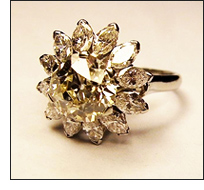featured item

quality pair of antique edwardian postal scales and weights Read more
Antique Rings
Posted by Gill Jones on 26/06/2013
 Not everyone is excited by jewellery, while others decorate their hands and wrists like Liberace. Other than wedding and engagement rings I am not particularly excited by it. I wear family heirlooms, but rarely purchase anything of interest. Modern jewellery is not my cup of tea.
Not everyone is excited by jewellery, while others decorate their hands and wrists like Liberace. Other than wedding and engagement rings I am not particularly excited by it. I wear family heirlooms, but rarely purchase anything of interest. Modern jewellery is not my cup of tea.
Antique rings on the other hand do excite me somewhat. I think it must be the sense of history and character each ring possesses, the story behind each one. Heartache or happy endings, each ring has its own unique story. I wear my own mother’s ring and other than reasons of sentimentality, antique rings often have stones of much higher quality, are often far more sophisticated and much more detail has gone into the making of them.
Rings have been around for thousands of years in practically every culture on earth, they’re important for what they symbolize as well as for decorating the hand. You pledge your love to someone with a ring and at one time rings were used to seal letters or sign documents. They can be talismans or an expression of faith, and they provide us with a rich and valuable insight into our past. The design of a ring can tell us so much about a certain period in time as can the materials that were used.
Victorian period
The Victorian periods for jewellery could easily be split into three as fashions and styles changed; there was the early Victorian period, the mid-Victorian period and the late. At the beginning of the period popular stones would be rose-cuts and brilliant diamonds, amethysts, topaz, rubies and cameos and mostly handcrafted. In the mid-Victorian period amethysts were still popular as were diamonds, but also emeralds, garnets and crystals, with onyx and jet. During the late Victorian period amethysts, moonstones, rubies and aquamarine were popular, but although there were significant advancements in jewellery making, manufacturing had replaced handcrafted pieces and were mass produced.
Although popular in the mid-Victorian period, the cameo ring on www.antiques.co.uk comes from around the late Victorian period/early 20 century, decorated with the head of Mercury, bearded and wearing a winged helmet.
Edwardian period
Edwardian rings are particularly interesting as this would be the final jewellery period to be distinguished by the name of a British monarch. This is the period where jewellery design would turn its back on machine made jewellery to a more nostalgic return to intricate and delicately designed pieces, and nothing appears more delicate than the exquisite emerald and diamond ring on www.antiques.co.uk, small yet with breath-taking detail, at its centre is a Colombian emerald surround by twelve small brilliant cut diamonds.
20th century
The 1920s period is particularly fascinating time for jewellery especially for rings during the art deco period. Inspiration for this came from Chinese, South American and African art. Cubism, which was famous for its angles, geometric lines was also a great influence. The idea was to get rid of any flowing lines and ostentation from previous styles and replace them with clean sharp lines and a return to machine made jewellery and modernism. The jade deco ring on www.antiques.co.uk is a perfect example of Chinese influence with its Chinese mounted gold and marquise-shape jade in apple green.
We could go back even further and to different countries as jewellery has a rich and noble past which shall continue to fascinate us. There is a wide choice of beautiful antique rings from Victorian to present day and you can find them on www.antiques.co.uk.



